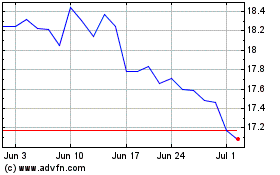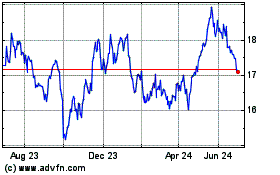PG&E Retires Power Line That Sparked California's Deadliest Wildfire
June 19 2019 - 7:58PM
Dow Jones News
By Katherine Blunt
PG&E Corp. has permanently retired the high-voltage power
line that sparked the deadliest wildfire in California's history
after detailed inspections of its electric system revealed serious
problems on that transmission line and others.
The company said Wednesday the inspections uncovered the need to
make thousands of repairs to its equipment. It said it already has
addressed the highest-priority safety risks with full repairs or
spot fixes, and will develop a plan to complete the remainder in
the coming months.
"We understand and recognize the serious concerns raised about
our infrastructure," said Sumeet Singh, vice president ofPG&E's
community wildfire-safety program. "We acknowledge that while we've
made progress, we have more work to do."
PG&E began a massive push to inspect the bulk of its
electric system late last year, after a section of its
Caribou-Palermo transmission line malfunctioned in November and
triggered the Camp Fire, which killed 85 people and destroyed the
town of Paradise.
A Wall Street Journal investigation in February found that
PG&E for years delayed maintenance work on towers and
conductors on the century-old line. The work was never completed
before the Camp Fire.
The line has been shut off since December, when the company
discovered extensive safety problems after climbing the towers.
PG&E had previously warned it might never re-energize the line
again.
California fire investigators officially concluded in May that
the line was the cause of the Camp Fire. The company had earlier
disclosed it was the likely culprit.
PG&E rushed to complete inspections on its electric system
ahead of California wildfire season, which began this month. The
inspections involved 50,000 transmission towers, 700,000
distribution poles and 222 substations connecting thousands of
miles of wires.
The company shared its inspection results with the California
Public Utilities Commission earlier this week. It said it would
make the status of the needed repairs, organized by city and
county, publicly available by July 15.
Through the inspections, the company also discovered that 10
transmission towers within the Golden Gate National Recreation Area
were at high risk of failure. A June 5 letter from PG&E's vice
president of electric operations reviewed by the Journal said the
towers are in "critical condition with noticeable material loss and
ground erosion" and require round-the-clock monitoring.
The company estimated it would take more than a year to replace
towers on a line in the area and make permanent repairs. It is now
assessing whether the line will need additional work.
The inspections were part of PG&E's wildfire-mitigation
plan, which involves trimming hundreds of thousands of trees away
from its power lines and installing technology to monitor fire risk
throughout its electric system. Mr. Singh said the company
anticipates the improvements to cost as much as $2.3 billion.
PG&E sought bankruptcy protection in January following a
series of deadly wildfires in 2017 and 2018. State fire
investigators have tied its equipment to 19 of those fires,
including the Camp Fire, and the company has estimated it could
face more than $30 billion in related liability costs.
The company earlier this week agreed to pay $1 billion to
compensate more than a dozen California cities, counties and
agencies for losses resulting from deadly wildfires sparked by its
equipment, marking the first major settlement since it sought
bankruptcy protection.
At the request of the CPUC, PG&E said it has hired a
consulting firm to investigate the cause of the safety problems on
the Caribou-Palermo line. It is now formulating more-stringent
inspection and maintenance plans to address longer-term concerns
about the safety of its power lines.
PG&E's disclosure Wednesday came as aides to California Gov.
Gavin Newsom met with state lawmakers to discuss measures to
financially assist the state's utilities, according to people
familiar with the matter.
California's investor-owned utilities have seen their credit
ratings drop due to concerns that they could face billions in
liability costs from wildfires. Political leaders are debating
provisions such as the creation of a wildfire fund to help with
those costs, as well as measures to help utilities spread out some
of the costs over time. In California, if a utility's equipment
sparks a fire, it is potentially liable for the resulting property
damage.
Mr. Newsom has set next month as a deadline to pass legislation
to address the problem, noting the urgency caused by PG&E's
bankruptcy. But he has conceded that finding political consensus on
the issue of rescuing the troubled company may be challenging.
--Alejandro Lazo contributed to this article.
Write to Katherine Blunt at Katherine.Blunt@wsj.com
(END) Dow Jones Newswires
June 19, 2019 19:43 ET (23:43 GMT)
Copyright (c) 2019 Dow Jones & Company, Inc.
PG&E (NYSE:PCG)
Historical Stock Chart
From Mar 2024 to Apr 2024

PG&E (NYSE:PCG)
Historical Stock Chart
From Apr 2023 to Apr 2024
